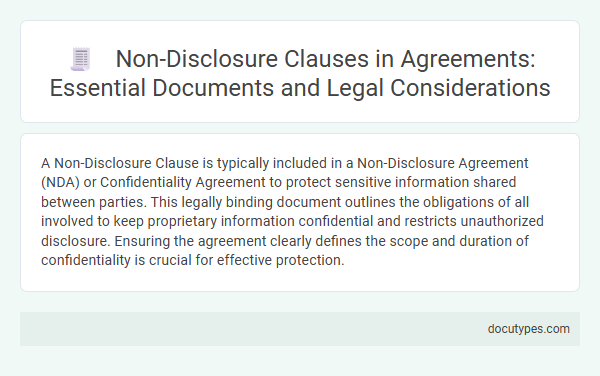A Non-Disclosure Clause is typically included in a Non-Disclosure Agreement (NDA) or Confidentiality Agreement to protect sensitive information shared between parties. This legally binding document outlines the obligations of all involved to keep proprietary information confidential and restricts unauthorized disclosure. Ensuring the agreement clearly defines the scope and duration of confidentiality is crucial for effective protection.
Introduction to Non-Disclosure Clauses in Agreements
Non-disclosure clauses protect sensitive information shared between parties during business relationships. Understanding which agreement document contains these clauses is crucial for maintaining confidentiality.
- Confidentiality Agreement - This agreement is specifically designed to outline the terms of information privacy between parties.
- Non-Disclosure Agreement (NDA) - A standalone NDA explicitly focuses on restricting the sharing of confidential information.
- Employment Contract - Some employment contracts include non-disclosure clauses to protect company secrets during and after employment.
Your careful selection of the appropriate document ensures the enforceability of the non-disclosure clause.
Importance of Non-Disclosure Clauses in Contracts
Non-disclosure clauses are essential in protecting sensitive information shared between parties during business collaborations. These clauses legally bind individuals or organizations to confidentiality, preventing unauthorized disclosure.
You need a Non-Disclosure Agreement (NDA) document to formalize these terms and safeguard proprietary data effectively. The NDA clearly outlines the scope, duration, and obligations related to confidential information, ensuring mutual trust.
Key Elements of Effective Non-Disclosure Clauses
An agreement document containing a non-disclosure clause must clearly define confidential information and outline the obligations of involved parties. Such a document is essential for protecting sensitive data during business interactions and collaborations.
Key elements of effective non-disclosure clauses include precise definitions of protected information, the duration of confidentiality obligations, and the permitted use of disclosed information. The clause should specify exclusions, such as publicly available data or information independently developed. Enforcement terms and consequences for breaches also enhance the clause's effectiveness.
Types of Information Covered by Non-Disclosure Clauses
| Type of Agreement Document | Description |
|---|---|
| Non-Disclosure Agreement (NDA) | A formal document specifically designed to protect confidential information shared between parties. It clearly outlines the scope of information that must remain private. |
| Confidentiality Agreement | Often integrated within employment contracts or partnership agreements, this clause restricts disclosure of sensitive business data or intellectual property. |
| Mutual Non-Disclosure Agreement | Used when both parties exchange confidential information, establishing reciprocal obligations to protect shared secrets. |
| Unilateral Non-Disclosure Agreement | Applicable when only one party discloses sensitive data, ensuring Your information remains protected without reciprocal obligations. |
| Proprietary Information Agreement | Focuses on safeguarding proprietary business information such as trade secrets, formulas, and processes that require heightened confidentiality. |
Duration and Scope of Confidentiality Obligations
Which agreement document is required to outline the duration and scope of confidentiality obligations in a non-disclosure clause? A Non-Disclosure Agreement (NDA) specifically defines the time period during which information must remain confidential. This document also details the extent and limits of the confidentiality obligations protecting sensitive information.
Exceptions to Non-Disclosure Obligations
The agreement document required for a non-disclosure clause typically includes a Non-Disclosure Agreement (NDA) or confidentiality agreement. Exceptions to non-disclosure obligations often cover information already known, publicly available data, or disclosures required by law. You must clearly understand these exceptions to avoid unintentional breaches of confidentiality terms.
Legal Consequences of Breaching Non-Disclosure Clauses
A Non-Disclosure Agreement (NDA) is the essential document required to establish a non-disclosure clause between parties. This agreement legally binds the parties to protect confidential information shared during their relationship.
Breaching a non-disclosure clause can result in severe legal consequences including monetary damages and injunctions. Courts may enforce penalties to compensate for losses and prevent further unauthorized disclosure of sensitive information.
Drafting Tips for Non-Disclosure Clauses in Agreements
Non-disclosure clauses are essential components of confidentiality agreements designed to protect sensitive information. Selecting the appropriate agreement document ensures legal enforceability and clarity between parties.
- Use a Standalone Non-Disclosure Agreement (NDA) - This document specifically focuses on confidentiality obligations, making it clear and enforceable.
- Incorporate Non-Disclosure Clauses in Broader Contracts - Confidentiality provisions can be embedded within employment, partnership, or service agreements to cover information sharing consistently.
- Be Precise with Definitions and Scope - Clearly define confidential information and outline the duration and exceptions to avoid ambiguity and legal disputes.
Common Mistakes to Avoid in Non-Disclosure Clauses
Choosing the correct agreement document for a non-disclosure clause is critical to ensuring confidential information is legally protected. Understanding common mistakes to avoid can prevent enforceability issues and protect all parties involved.
- Using a generic contract without a specific NDA section - This can result in vague obligations and weaken confidentiality protections.
- Failing to define confidential information clearly - Ambiguity about what constitutes confidential material leads to disputes and limits enforcement.
- Omitting duration and scope of confidentiality - Without clear timeframes and boundaries, non-disclosure obligations may be ineffective or overly broad.
Which Agreement Document Is Required for a Non-Disclosure Clause? Infographic

